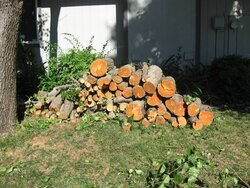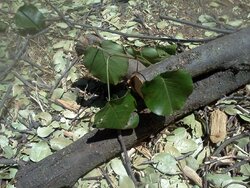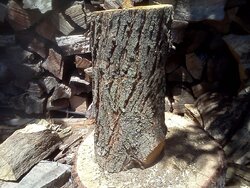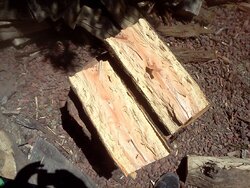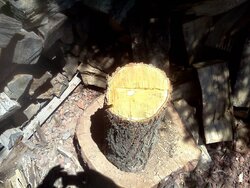Name This Wood ID
- Thread starter Mr A
- Start date
-
Active since 1995, Hearth.com is THE place on the internet for free information and advice about wood stoves, pellet stoves and other energy saving equipment.
We strive to provide opinions, articles, discussions and history related to Hearth Products and in a more general sense, energy issues.
We promote the EFFICIENT, RESPONSIBLE, CLEAN and SAFE use of all fuels, whether renewable or fossil.
You are using an out of date browser. It may not display this or other websites correctly.
You should upgrade or use an alternative browser.
You should upgrade or use an alternative browser.
- Status
- Not open for further replies.
Woody Stover
Minister of Fire
Is there a moat filled with crocodiles? Maybe you could zoom in... Pic of a split would be nice, if you can sneak in and get one of those rounds whilst the crocs sleep... 





PA. Woodsman
Minister of Fire
I'm thinking Mulberry, because there are some yellow cutsides and some reddish brown pieces. Fresh cut Mulberry starts as yellow and turns reddish-brown as it dries.
Adios Pantalones
Minister of Fire
Applesister
Minister of Fire
My cell phone is giving me headaches. Cant see anything clear enough to cheat and use my 'library'. MrA, do YOU know what this wood is?
Im seeing bright pumpkin orange wood thanks to digital imagery. Dunno, cant even take researched guess.
Im seeing bright pumpkin orange wood thanks to digital imagery. Dunno, cant even take researched guess.
Woody Stover
Minister of Fire
Natural range of the Red Mulberry we know is a good distance east of CA. Bark on the tree trunk doesn't seem similar either. Leaves look like a maybe...I'm thinking Mulberry, because there are some yellow cutsides and some reddish brown pieces. Fresh cut Mulberry starts as yellow and turns reddish-brown as it dries.
Leaves don't look right...should look more like Shingle Oak leaves (don't know if you've seen those out there.) Those look like some wide leaves...In Norther CA- I'm thinking live oak
What we have to work with might help us more if we were familiar with the western trees...cant even take researched guess.
Adios Pantalones
Minister of Fire
Natural range of the Red Mulberry we know is a good distance east of CA. Bark on the tree trunk doesn't seem similar either. Leaves look like a maybe...
Leaves don't look right...should look more like Shingle Oak leaves (don't know if you've seen those out there.) Those look like some wide leaves...
What we have to work with might help us more if we were familiar with the western trees...
I didn't see leaves, unless the ones on the ground are the right ones
PA. Woodsman
Minister of Fire
I didn't see leaves, unless the ones on the ground are the right ones
He said the leaves in the lower right corner.
Once again, please whack a round in half and post pictures of the grain close up so we can make a better decision!
blujacket
Minister of Fire
Yea, it's a fruitless ornamental pear. Probably Bradford pear. Guy paid me to $100 to take it away for him. Along with a few fallen branches that I hacked up with a lawn mower. It took me about 2 hours to chop it all up and dumped it for free at the utility companies waste pile for tree trimmings.
Applesister
Minister of Fire
raybonz
Minister of Fire
I think he was referring to tossing out chipped up branches..So you tossed it? Im confused.
Paulywalnut
Minister of Fire
Wood Duck
Minister of Fire
In Norther CA- I'm thinking live oak
There are plenty of Mulberry in California. It is a common shade tree there. However, this is a Callery ('Bradford') Pear, which is also common in California.
A lot of fruitless mulberry. I have yet to see any with red or white berries. I kept the bigger pieces, dumped the rest. I guess it burn the same as regular pear?There are plenty of Mulberry in California. It is a common shade tree there. However, this is a Callery ('Bradford') Pear, which is also common in California.
PA. Woodsman
Minister of Fire
The split picture certainly looks like Pear like we have here in PA. I'm just suprised how yellow the cutside of some of the rounds are when others are orange color? I've never seen Pear with yellow cutsides like that-it's almost like this was from different trees but you're saying it was all from the same tree?
Applesister
Minister of Fire
Thats pretty smart to ID a genetically altered ornamental.ornamental pear
My guess about comparing wood would only be based on whether the cut wood was very heavy. I never heard of Bradford pears so I googled it. The trees are notorious for weak crotches and breakage during storms. But that could just mean the wood is brittle.
Well thanks MrA for posting this one. Great job Blujacket.
blujacket
Minister of Fire
Thats pretty smart to ID a genetically altered ornamental.
My guess about comparing wood would only be based on whether the cut wood was very heavy. I never heard of Bradford pears so I googled it. The trees are notorious for weak crotches and breakage during storms. But that could just mean the wood is brittle.
Well thanks MrA for posting this one. Great job Blujacket.
Thanks. I burned some last year, and it's rather good.
PA. Woodsman
Minister of Fire
Thanks. I burned some last year, and it's rather good.
It's very good-dries pretty quickly, ignites and burns nicely. And yes it cracks very easily in storms; have gotten lots of it for that reason. Good stuff!
I'm not that smart, homeowner told me what it was. It is some sort of ornamental, fruitless pear, Bradford may not be correctThats pretty smart to ID a genetically altered ornamental.
Two trees in yard, so could be from one or the other. The split comes from the pie in first pic, could be lighting, or another few days drying making it look yellow. Homeowner is having the trees completely removed, so may be getting some more soon. Good to hear it burns well. I might try some on the barbecueI've never seen Pear with yellow cutsides like that-it's almost like this was from different trees but you're saying it was all from the same tree?
PA. Woodsman
Minister of Fire
I'm not that smart, homeowner told me what it was. It is some sort of ornamental, fruitless pear, Bradford may not be correct
Two trees in yard, so could be from one or the other. The split comes from the pie in first pic, could be lighting, or another few days drying making it look yellow. Homeowner is having the trees completely removed, so may be getting some more soon. Good to hear it burns well. I might try some on the barbecue
I cooked over Pear already and it was great!
I just don't remember ever cutting any Pear and seeing it yellow like that; what about you guys? It's always that orange color but who knows....and that is a pretty good size Pear tree based on the bigger rounds in the first picture; the ones that I get here are smaller when they get damaged from storms-that there has some good "meat" on it!
- Status
- Not open for further replies.
Similar threads
- Replies
- 18
- Views
- 1K


